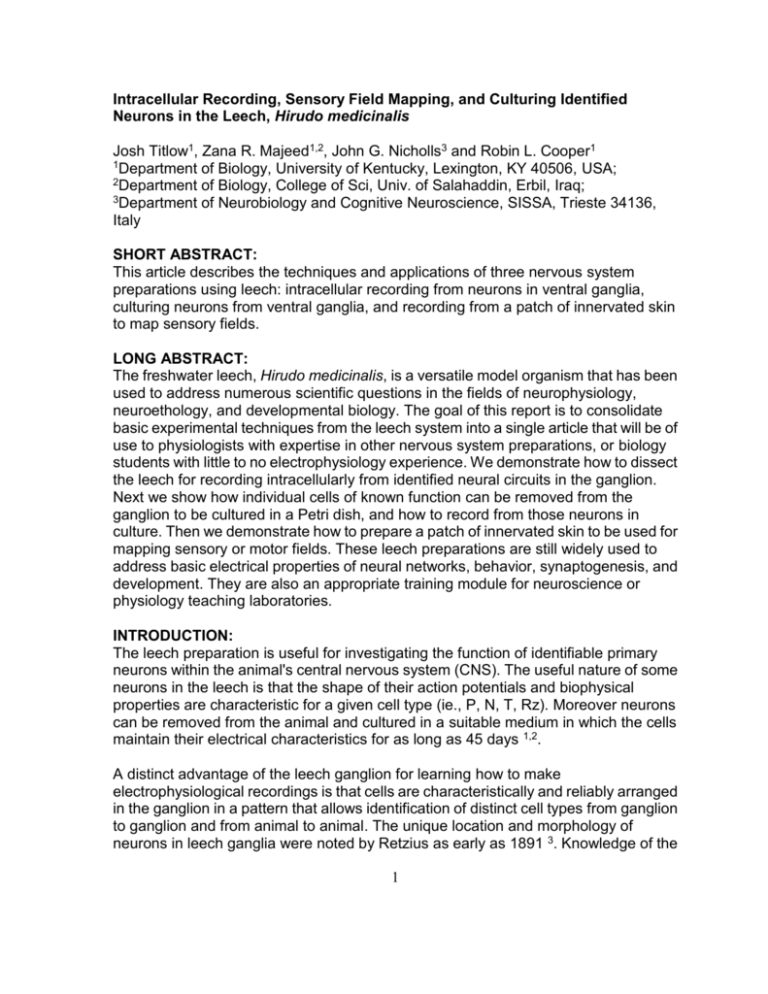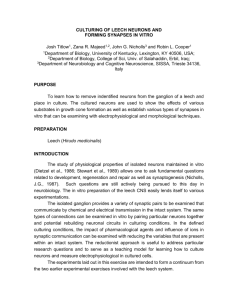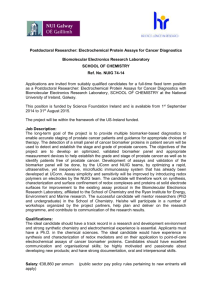Intracellular Recording, Sensory Field Mapping, and Culturing
advertisement

Intracellular Recording, Sensory Field Mapping, and Culturing Identified
Neurons in the Leech, Hirudo medicinalis
Josh Titlow1, Zana R. Majeed1,2, John G. Nicholls3 and Robin L. Cooper1
1Department of Biology, University of Kentucky, Lexington, KY 40506, USA;
2Department of Biology, College of Sci, Univ. of Salahaddin, Erbil, Iraq;
3Department of Neurobiology and Cognitive Neuroscience, SISSA, Trieste 34136,
Italy
SHORT ABSTRACT:
This article describes the techniques and applications of three nervous system
preparations using leech: intracellular recording from neurons in ventral ganglia,
culturing neurons from ventral ganglia, and recording from a patch of innervated skin
to map sensory fields.
LONG ABSTRACT:
The freshwater leech, Hirudo medicinalis, is a versatile model organism that has been
used to address numerous scientific questions in the fields of neurophysiology,
neuroethology, and developmental biology. The goal of this report is to consolidate
basic experimental techniques from the leech system into a single article that will be of
use to physiologists with expertise in other nervous system preparations, or biology
students with little to no electrophysiology experience. We demonstrate how to dissect
the leech for recording intracellularly from identified neural circuits in the ganglion.
Next we show how individual cells of known function can be removed from the
ganglion to be cultured in a Petri dish, and how to record from those neurons in
culture. Then we demonstrate how to prepare a patch of innervated skin to be used for
mapping sensory or motor fields. These leech preparations are still widely used to
address basic electrical properties of neural networks, behavior, synaptogenesis, and
development. They are also an appropriate training module for neuroscience or
physiology teaching laboratories.
INTRODUCTION:
The leech preparation is useful for investigating the function of identifiable primary
neurons within the animal's central nervous system (CNS). The useful nature of some
neurons in the leech is that the shape of their action potentials and biophysical
properties are characteristic for a given cell type (ie., P, N, T, Rz). Moreover neurons
can be removed from the animal and cultured in a suitable medium in which the cells
maintain their electrical characteristics for as long as 45 days 1,2.
A distinct advantage of the leech ganglion for learning how to make
electrophysiological recordings is that cells are characteristically and reliably arranged
in the ganglion in a pattern that allows identification of distinct cell types from ganglion
to ganglion and from animal to animal. The unique location and morphology of
neurons in leech ganglia were noted by Retzius as early as 1891 3. Knowledge of the
1
identity and function of a neuron is advantageous for investigating neural circuits and
for making experiments with a given cell type. Due to the relatively large somata of the
neurons within a ganglion they are visible with a dissecting microscope, and the
somata can be selectively impaled with microelectrodes for recording their electrical
properties.
Several types of ionic currents have been identified that give rise to the various
shapes of the characteristic action potentials in various neurons 4-7. From
investigations in the pattern of innervation and branching of individual neurons within
the CNS, the synaptic connections have been reproduced in culture with identified
neurons 2,8. Studies in the leech ganglia have provided insight into the development of
functional circuits that can be measured with electrophysiology as well as with whole
animal behavior studies. The leech CNS has also served as a valuable preparation for
investigating mechanisms involved with neuronal repair and regeneration in the whole
animal and in culture 4-6,9-12.
In mammalian brains it is a daunting task to explain behavior in terms of the properties
and connections of individual identified neurons. In principle one can hope that the
study of less complex systems such as the leech could help to define basic
mechanisms used in higher animals. The connections that are used which underlie a
swim pattern 13,14 and rhythmicity of the heart 15 have been fairly well characterized in
the leech. The ability of some leech neurons to form both electrical and chemical
communication is intriguing. Some connections are bidirectional while others are
unidirectional chemically but bidirectionally electrically 7. Understanding the synaptic
connections within the animal as well as recreating the same type of connections in a
culture dish are powerful tools for investigating synaptogenesis 16-18 as well as
pharmacological profiling of synapses 19. The intracellular recording and stimulation
techniques described here provide a foundation for pharmacological assays and
research in neuroethology and development.
In addition, the segmental ventral nerve cord can be dissected with a patch of
innervated skin. With the ability to keep a patch of skin and the neurons alive, sensory
receptive fields can be probed by recording electrical signals from the cell body (i.e.,
soma) of sensory neurons within respective abdominal ganglion in the CNS. Thereby
one can assess the sensitivity of the sensory endings by applying varying degrees of
force on the skin and map receptive fields: light touch, pressure, and noxious (painful)
stimuli 20,21.
An advantage of this leech ganglion-skin preparation is that one can draw
anatomically the receptive map and trace the neuronal processes to the identified
neuron once the electrical responses are being recorded. In addition, the synaptic
connections to other neurons can be mapped to parallel electrical measures within
neural circuits in the ganglion. The three separate leech experiments described below
can all be completed multiple times with a single specimen, which makes this a cost
2
effective teaching module for academic laboratories.
PROCEDURE:
{For 3 page limit the yellow parts are essential}
1) Preparation of electrodes and saline solution
1.1) Prepare physiological saline and electrodes before the animal is dissected. Leech
Ringer’s solution consists of the following: 115.3 mM NaCl, 1.8 mM CaCl2, 4.0 mM
KCl, 10 mM Tris/Maleic acid or HEPES. Adjust the pH to 7.4.
1.2) Prepare a Ag-Cl wire by dipping a cleaned silver wire into a small amount of
bleach for 20 minutes or until the wire has a smooth dark gray finish. Wash the wire
with distilled water before using. Then place the wire into a micropipette holder that
plugs into the amplifier.
1.3) Prepare a sharp glass electrode of borosilicate glass using a pipette puller. The
electrode resistance should be on the order of 20 MΩ.
1.4) Backfill the pipette with 3M potassium acetate solution and insert in into the
micropipette holder.
1.5) For an extracellular electrode prepare a sharp glass pipette as described above,
break the tip back by rubbing another sharp pipette near the sharp edge. Then fire
polish the tip so that it does not tear the connectives. Nonglass extracellular
electrodes will also work as long as there is good contact between the electrode and
the nerve.
1.6) Insert the extracellular recording electrode into a micropipette holder (with Ag-Cl
wire) that is fitted with a rubber tube and syringe for suction. Use the syringe to draw
saline into the electrode at least to the level of the silver wire.
1.7) Set up the hardware (amplifier and stimulus isolator) and software recording
parameters by following the manual for your specific signal recording unit. See
Leksrisawat et al.22 to view details on equipment used in the experiments described
below.
2) Ventral ganglion dissection
2.2) Dissect the leech in a large silicone elastomer-lined dish with leech Ringer’s
solution. If the animal is stretched longitudinally as taut as possible it will be easier to
remove the ventral nerve cord (see Figure 1A).
2.3) With #10 or #11 size scalpel, make a longitudinal incision with very shallow cuts in
3
the ventral midline. About the middle 2/3rd of the ventral cut is shown in Figure 1B. Try
not to cut through the black stocking (the ventral blood sinus) until the animal is fully
opened and the blood sinus is stretched without kinks. This black blood sinus runs the
length of the animal along the ventral midline. The VNC is contained inside of this
blood vessel.
2.4) After the skin has been cut the full length of the animal, use the fine iris scissors to
nick the black sinus (Figure 2). Slip one blade of the fine iris scissors under the sinus
and slightly raise the blade to pull up on the stocking. Cut the sinus the length of the
VNC while avoiding the nerve roots, segmental nerves, or the connectives between
ganglia.
2.5) Next, remove part of the ventral nerve cord by cutting the roots distal to where the
blood vessel joins the roots. Repeat this process for each ganglion along the length of
the ventral nerve cord.
2.6) Transfer a segment of one or two ganglia to a smaller Petri dish. The ganglia or
the single ganglion needs to be pinned taut with some slack.
2.7) Pin the connectives and the roots so the ganglion glial sheath is slightly stretched
to prevent the neuron cell bodies from moving around when impaling through the glial
sheath and into the neuron of interest. The pins should be placed through the black
sinus for the roots and in the middle of the two connectives to minimize damage of the
axons (Figure 3).
2.8) Place the Petri dish with preparation under the microscope and secure it with wax
at the bottom of the dish to prevent movement.
2.9) Carefully focus the light beam using a mirror and light condenser to see the
neurons as in Figure 4. Notice the two large Retzius cells in the center of the ganglion.
2.10) To make an intracellular recording of the Rz, T, P, and N neurons, carefully
place the tip of the electrode over the cell of interest and gently lower the tip until a
dimple is seen in the glial sheath.
2.11)Tap the electrode holder or manipulator (very carefully) so that the electrode tip
“pops” into the cell of interest.
3) Culturing neurons from the ventral ganglion preparation
3.1) Pin the ganglia ventral side up in a clean dish containing L-15 with fetal calf serum
(FCS) (Figure 4). Pin the roots so that the ganglia are slightly stretched as done above
for intracellular recordings. With fine scissors, nick the glial capsule at one end, slip
one scissors blade under the capsule, then cut across the glial capsule as shown in
4
Figure 5A.
3.2) Add 100 µl aliquot of Collagenase/Dispase to the dish and place on a shaker for
15 min. Examine cells by moving the culture media around the exposed cell bodies.
Return the cells to the shaker for another 15 min or longer until the cells come out with
slight sucking.
3.3) Use a pipette attached to a syringe to gently extract cells from the ganglion. Fire
polish the pipette tip so that it is slightly larger than the cell body diameter. For Rz cells
in an adult leech, the diameter should be around 50 µm.
3.4) Prepare a variety of pipettes with different diameters without a filament as this
decreases the chances of the cells sticking inside the pipette. Store the pipettes in a
bottle containing 80% ethanol (EtOH) using a cotton ball at the bottom to protect the
tips from chipping. Remember to wash the EtOH out of the pipette with medium before
aspirating cells.
3.5) After the enzyme treatment, wash out the enzyme-containing medium with L-15
(with FCS) two times. Identify the cells of interest and gently draw them into the pipette
by pulling the syringe. Discharge the aspirated cells into another dish which contains
L-15 (with FCS).
3.6) Until now, all procedures were nonsterile. Perform the following steps in a sterile
hood. Place 3 to 4 large drops of sterile L-15 (with FCS) in different locations inside a
sterile Petri dish.
3.7) Pipette the cells into one of the before-mentioned drops, blowing them around in
the drop to wash them. Repeat this in series in 3 or 4 drops of medium.
3.8) Place cells in a clean Petri dish filled with L-15 (with FCS).
3.9) Incubate the cells for 1-24 hours at room temperature. Afterwards the clean cells
can be plated. By leaving the cells for a few hours or overnight the extracellular matrix
comes off easily. Plate the cells immediately to generate longer processes (Figure
6A).
3.10) Use sterile substrate to coat a microwell dish and allow it to dry completely
(overnight) before culturing experiments.
3.11) After the dish has been coated, wash the dish gently with sterile water and then
with a small amount of the L-15 medium. Remember to use the L-15 solution without
the FCS added to allow the cells to adhere to the dish. The medium can be gently
changed to L-15 with FCS after the cells have adhered to the substrate. If the cells are
to be used a few hours after plating, then switching the medium to L-15 with FCS is not
5
necessary.
3.8) Position the cells next to each other at the time of plating to induce rapid
synaptogenesis (Figure 6B). After 24 hr measure physiological activity in pairings of
neurons.
3.9) Use intracellular electrophysiological techniques to record RP or synaptic
responses in cultured pairs of cells (stimulate 1 neuron through an intracellular
electrode and record responses from the paired cell using a 2nd intracellular
electrode).
4) Ganglion-body wall preparation
4.1) Pin the leech dorsal side down in an elastomer-lined dish as described above.
4.2) Pin the skin to one side with roots on the other side of the severed ganglion
(Figure 7A, magnified 7B) or make a window on the ventral aspect of the leech over a
ganglion (Figure 7C) with all the roots to the body wall intact.
4.3) After obtaining a stable intracellular recording in one of the sensory cells (T, P, N)
use a small glass rod that has been fire polished to lightly touch the skin in the same
segment. If the neuron being recorded from is an N cell then a more forceful pressure
will need to be applied to the skin. In most cases, the N cell will only respond if the skin
is pinched with tweezers. For this reason these cells should be tried last as one might
damage the skin or displace the intracellular recoding by disturbing the preparation in
such a manner.
4.4) One should be able to quickly sketch the skin and ganglion with details sufficient
enough that a map of where one touched can be used to determine the receptive field
for a particular neuron. After recording from as many T and P cells as possible on both
sides of a ganglion try the N cells.
4.5) In order to examine if the sensory neurons have processes that travel through the
connectives in a rostral or caudal manner and then out the roots in the adjoining
segment to the skin, the connectives between ganglia can be cut and the receptive
fields reexamined in regards to the spread of detection. Basically one is examining if
there has been any loss in the receptive field.
RESULTS:
Intracellular recordings from neurons in the leech ganglion are characterized by their
distinct voltage-time traces shown in Figure 8. The resting cell membrane potential in
healthy leech ganglion cells are -45 to -60 mV. If potentials are smaller (less negative)
6
one should change the glass electrode, or if the potential is still low, move on to
another segment of the nerve cord.
Injecting current into the cells using an intracellular electrode provides an opportunity
to study biophysical properties of the neurons, e.g. spike threshold, membrane
resistance, and inactivation of voltage-gated ion channels. Positive current injections
can activate cells that are not tonically active. This is demonstrated in Fig. 8A, where a
train of action potentials is seen for the duration of three separate current injections.
Positive current injections in a tonic neuron increases the firing rate but decreases the
spike amplitude (Fig. 8B). At its resting membrane potential a percentage of the
voltage-gated ion channels are inactivated. Hyperpolarizing current inhibits the
inactivated confirmation, increasing the number of channels that can open in
response to a depolarizing stimulus. The result is a larger flux that results in large
spike amplitudes and a higher frequency of action potentials (Fig. 8C). This is one of
the many principles of neurophysiology that can be demonstrated using this
preparation in undergraduate teaching laboratories.
Intercellular communication can be demonstrated by stimulating the nerve roots or
connectives and recording from neurons in the ganglion. Stimulating these nerves
generates robust EPSPs and action potentials in different ganglion cells. The trace in
Figure 9 was recorded from a Retzius cell in a ganglion that had been removed from
the animal and pinned out in a dish. Resting potential is -49 mV. A stimulus artifact is
seen 24.9 msec before the action potential peaks. The spike amplitude in this
recording is 28.43 mV, which is relatively low for this cell type.
Primary cultures of neurons from the leech ganglion form synapses in the dish. These
networks are viable for days under the conditions described. The resting and excitable
membrane properties of single or paired neurons forming synapses in culture are also
readily obtainable1,2.
Figure 1. Ventral leech dissection. (A) The animal is thoroughly pinned ventral side
up in an elastomer-lined dish filled with leech saline. (B) A shallow incision
spanning the anterior:posterior axis is made just lateral to the midline to avoid
damaging the nerve cord. The black blood sinus (which contains the ventral nerve
cord) can easily be seen. Note the one exposed ganglion that is white compared to
the sheath.
Figure 2. Dissection of the black sinus. The blood vessel (arrow) should be carefully
cut on one side to expose the ventral nerve cord (double arrow). Leave segments of
the blood vessel intact around the segmental roots for use as a handle for
manipulating the ventral nerve cord when transferring between dissection and
recording dishes.
Figure 3. Isolated section of the ventral nerve cord. Pinning the ventral nerve cord by
the blood vessel fragments remaining on the segmental roots and at the
7
ends of the segmental connectives exposes the ganglia for electrophysiological
recordings. A taut stretching of the ganglia allows one to see the identifiable cell
bodies and will allow an easier penetration of the glial sheath with a sharp glass
electrode.
Figure 4. Cellular anatomy of the leech ganglion. (A) Ideally the Retzius cells (R) and
other large cell bodies (P- pressure, T- touch, N-nocieptive, AE- annulus erector) will
be clearly visible if the microscope and light condenser are set up properly.
Figure 5. Desheathing the ganglion to remove individual cell bodies. (A) The glial
sheath should be carefully cut across the ganglion to avoid damaging cells of interest.
The red line indicates a cut to avoid hitting the soma of the Rz neurons. Opening the
sheath allows access to the digestive enzymes to the connective matrix. (B) Healthy
cell bodies bulging out of the ganglion after the glial sheath has been opened.
Figure 6. Cultured leech neurons. (A) Cells are aspirated from the ganglion and
cultured on a dish containing a culture media. (B) Placing multiple cells near one
another will increase the rate of synaptogenesis between identifiable neurons. Here
the stumps of two neurons are almost touching. Scale bar 100 µm.
Figure 7. The leech ganglion-body wall preparation for mapping receptive fields. (A)
One approach is to remove an entire section of the body wall along with 2-3 ganglia.
Here the roots on one side have been cut and the ganglia have been pinned out to the
side. (B) A higher magnification illustrates three ganglia next to the skin. (C) Another
approach is to create a small window in the body wall and record from the intact
ganglia while mapping a receptive field.
Figure 8. Representative traces from cell bodies in the dissected ganglion preparation.
Current-time traces are shown above their corresponding voltage-time traces. (A)
Action potentials evoked in an inactive cell by injecting depolarizing current with the
intracellular electrode. (B) Increasing the magnitude of current injection increases the
firing frequency in one of the ganglion cells. (C) Hyperpolarizing the cell inhibits
inactivation of voltage-gated ion channels. Note the increase in spike amplitude and
frequency following the injection of negative current (Scale bar = 10mV/10nA and
10msec).
Figure 9. Evoked activity in the leech ganglion. Extracellular stimulation of the
connectives can be used to drive synaptic transmission in the nerve cord. At the top of
the photo a suction electrode is attached to one of the connectives. The sharp glass
electrode from the right of the photo is impaling a Retzius cell in the ganglion. A
voltage-time trace from this recording is shown on the right. A stimulus artifact
(arrow) is followed by a spike recorded from the soma (scale bar is 10mV/10msec).
DISCUSSION:
8
The purpose of this set of experiments was 1) to teach and exhibit the fundamental
principles of intracellular recordings from identifiable neurons and 2) to recognize the
characteristic shapes of electrical signals that can arise from these particular neuronal
types using adult leeches. There is a rich history of investigations using the leech for
neurophysiological investigations and research is ongoing in addressing questions of
neural circuitry and gene regulation during development as well as during synaptic
repair and regeneration 26-34. Neuromodulation, particularly through biogenic amine
pathways, has also been a successful research direction in the leech. By adding
dopamine and other pharmacological agents to the nervous system through the saline
solution, it has been shown that dopamine modulates neural networks involved in
decision-making 23 and motor patterns for crawling behavior 24,25. This experimental
approach is a simple (and inexpensive) way to incorporate modulation into the
teaching laboratory, and adjusting the ionic makeup of the saline solution is an
effective way to teach the Nernst and Goldman-Hodgkin-Katz equations.
To be successful with the ganglion preparations it is important to have the ganglion
taut prior to attempting to poke a soma with an intracellular electrode. Otherwise the
soma will move when pushing down on the glial packet. In addition, when desheathing
the ganglion for removing neurons for culture, avoid the region of interest when cutting
across the ganglion so somas are not damaged as they are removed. Also, excessive
incubation in the enzymes may result in the neurons being too fragile to be removed. It
requires some trial and error to achieve an ideal incubation time because each batch
of enzymes is slightly different in their actions.
Further investigation to optimize culture media could improve this technique. Various
factors, such as the presence of insulin, sugars, or growth factors could be examined
for longer maintenance of cultures. Examining if cells maintain biochemical properties
in syntheses of transmitters, such as if serotonin remains high in Rz cells, can be
examine by simple neutral red staining. Also microglial invasion to injured and
regenerating sites in the intact VNC can be quantified by nuclear stains days after an
injury. With the adults, housing the leeches is relatively easy for several weeks
however it takes substantial effort to develop and maintain a colony. Literature in
leech husbandry is ready available on the internet for those wishing for more detail.
Although this preparation has many benefits to offer in examining regeneration and
repair as well as neural circuitry, the pharmacological and molecular identification of
the various receptor subtypes at synapses have not been fully characterized. An
expressed sequence tag library is available26, and the medicinal leech genome is
currently being assembled, 27 but the main limitation in leech compared to some model
preparations is the ability to modify the genome for selective genes in specific cell
types. In embryos this limitation has been addressed by injecting DNA or dsRNA to
regulate gene expression28. The gene gun technique has recently been used to
express invertebrate connexin (innexin) proteins in leech neurons. Expression of an
innexin from Hirudo verbana (Hve-inx6) is sufficient for the formation of ectopic gap
9
junctions in the medicinal leech 29. The medicinal leech –or H. verbena as it were (see
Siddall et al., 200730)– is sure to advance our understanding of the physiology and
evolution of electrical synapses over the next few years.
REFERENCES:
1
Fuchs, P. A., Nicholls, J. G. & Ready, D. F. Membrane properties and selective
connexions of identified leech neurones in culture. Journal of Physiology 316,
203-223 (1981).
2
Ready, D. F. & Nicholls, J. Identified neurones isolated from leech CNS make
selective connections in culture. Nature 281, 67-69 (1979).
3
Blackshaw, S. E. in Neurobiology of the Leech (ed K.J. Muller, Nicholls, J.G.,
and Stent, G.S.) 51-78 (Cold Spring Harbor Laboratory, 1981).
4
Drapeau, P. & Sanchez-Armass, S. Parallel processing and selection of the
responses to serotonin during reinnervation of an identified leech neuron.
Journal of Neurobiology 20, 312-325, doi:10.1002/neu.480200505 (1989).
5
Garcia, U., Grumbacher-Reinert, S., Bookman, R., and Reuter, H. Distribution
of Na+ and K+ currents in soma, axons, and growth cones of leech Retzius
neurones in culture. Journal of Experimental Biology, 1-17 (1990).
6
Cooper, R. L., Fernandez, de Miguel, F., Adams, W.B., and Nicholls, J.G.
Synapse formation inhibits expression of calcium currents in purely
postsynaptic cells. Proceedings of Royal Society B-Biological Sciences,
217-222 (1992).
7
Liu, Y. & Nicholls, J. Steps in the development of chemical and electrical
synapses by pairs of identified leech neurons in culture. Proceedings of Royal
Society B-Biological Sciences, 236, 253-+, doi:10.1098/rspb.1989.0023
(1989).
8
Fernandezdemiguel, F., Cooper, R. L. & Adams, W. B. Synaptogenesis and
calcium current distribution in cultured leech neurons. Proceedings of Royal
Society B-Biological Sciences, 247, 215-221, doi:10.1098/rspb.1992.0032
(1992).
9
Briggman, K. L. & Kristan, W. B. Multifunctional pattern-generating circuits.
Annual Review of Neurosciences 31, 271-294,
doi:10.1146/annurev.neuro.31.060407.125552 (2008).
10
Macagno, E. R., Muller, K. J. & Deriemer, S. A. Regeneration of axons and
synaptic connections by touch sensory neurons in the leech central
nervous-system. Journal of Neuroscience. 5, 2510-2521 (1985).
11
Becker, T. & Macagno, E. R. CNS control of a critical period for peripheral
induction of central neurons in the leech. Development 116, 427-434 (1992).
12
Marin-Burgin, A., Kristan, W. B. & French, K. A. From Synapses to behavior:
Development of a sensory-motor circuit in the leech. Developmental
Neurobiology 68, 779-787, doi:10.1002/dneu.20551 (2008).
13
Kristan, W. B. The neurobiology of swimming in the leech. Trends Neurosci. 6,
84-88, doi:10.1016/0166-2236(83)90044-9 (1983).
10
14
15
16
17
18
19
20
21
22
23
24.
25
26
27
Brodfuehrer, P. D. & Friesen, W. O. From stimulation to undulation: a neuronal
pathway for the control of swimming in the leech. Science 234, 1002-1004,
doi:234/4779/1002 [pii] 10.1126/science.234.4779.1002 (1986).
Arbas, E. A. & Calabrese, R. L. Slow oscillations of membrane potential in
interneurons that control heartbeat in the medicinal leech. J Neurosci 7,
3953-3960 (1987).
Ching, S. Synaptogenesis between identified neurons, McGill University,
(1995).
Kristan, W. B., Eisenhart, F. J., Johnson, L. A. & French, K. A. Development of
neuronal circuits and behaviors in the medicinal leech. Brain Res. Bull. 53,
561-570, doi:10.1016/s0361-9230(00)00390-7 (2000).
Todd, K. L., Kristan, W. B., Jr. & French, K. A. Gap junction expression is
required for normal chemical synapse formation. J Neurosci 30, 15277-15285,
doi:10.1523/JNEUROSCI.2331-10.201030/45/15277 [pii] (2010).
Li, Q. & Burrell, B. D. Two forms of long-term depression in a polysynaptic
pathway in the leech CNS: one NMDA receptor-dependent and the other
cannabinoid-dependent. J Comp Physiol A Neuroethol Sens Neural Behav
Physiol 195, 831-841, doi:10.1007/s00359-009-0462-3 (2009).
Nicholls, J. G. & Baylor, D. A. Specific modalities and receptive fields of
sensory neurons in CNS of the leech. J Neurophysiol 31, 740-756 (1968).
Yau, K. W. Receptive fields, geometry and conduction block of sensory
neurones in the central nervous system of the leech. J Physiol 263, 513-538
(1976).
Leksrisawat, B., Cooper, A. S., Gilberts, A. B. & Cooper, R. L. Muscle receptor
organs in the crayfish abdomen: a student laboratory exercise in
proprioception. J Vis Exp, doi:10.3791/23232323 [pii] (2010).
Crisp, K. M. & Mesce, K. A. Beyond the central pattern generator: amine
modulation of decision-making neural pathways descending from the brain of
the medicinal leech. J Exp Biol 209, 1746-1756, doi:209/9/1746
[pii]10.1242/jeb.02204 (2006)
Puhl, J. G. & Mesce, K. A. Dopamine activates the motor pattern for crawling in
the medicinal leech. J Neurosci 28, 4192-4200,
doi:10.1523/JNEUROSCI.0136-08.200828/16/4192 [pii] (2008).
Crisp, K. M., Gallagher, B. R. & Mesce, K. A. Mechanisms contributing to the
dopamine induction of crawl-like bursting in leech motoneurons. J Exp Biol
215, 3028-3036, doi:10.1242/jeb.069245
Macagno, E.R., Gaasterland, T., Edsall, L., Bafna, V., Soares, M.B., Scheetz,
T., Casavant, T., Da Silva, C., Wincker, P., Tasiemski, A. & Salzet, M.
Construction of a medicinal leech transcriptome database and its application
to the identification of leech homologs of neural and innate immune genes.
BMC genomics 11, 407 (2010).
Kandarian, B., Sethi, J., Wu, A., Baker, M., Yazdani, N., Kym, E., Sanchez, A.,
Edsall, L., Gaasterland, T.& Macagno, E. The medicinal leech genome
11
28
29
30
encodes 21 innexin genes: different combinations are expressed by identified
central neurons. Development genes and evolution 222, 29-44 (2012).
Shefi, O., Simonnet, C., Groisman, A. & Macagno, E.R. Localized RNAi and
ectopic gene expression in the medicinal leech. Journal of visualized
experiments: JoVE. 14, e697, doi:10.3791/697 (2008).
Firme, C.P., 3rd, Natan, R.G., Yazdani, N., Macagno, E.R.& Baker, M.W.
Ectopic expression of select innexins in individual central neurons couples
them to pre-existing neuronal or glial networks that express the same innexin.
The Journal of Neuroscience 32, 14265-14270 (2012).
Siddall, M.E., Trontelj, P., Utevsky, S.Y., Nkamany, M. & MacDonald, K.S..
Diverse molecular data demonstrate that commercially available medicinal
leeches are not Hirudo medicinalis. Proceedings. Biological sciences / The
Royal Society 274, 1481-1487 (2007).
12








